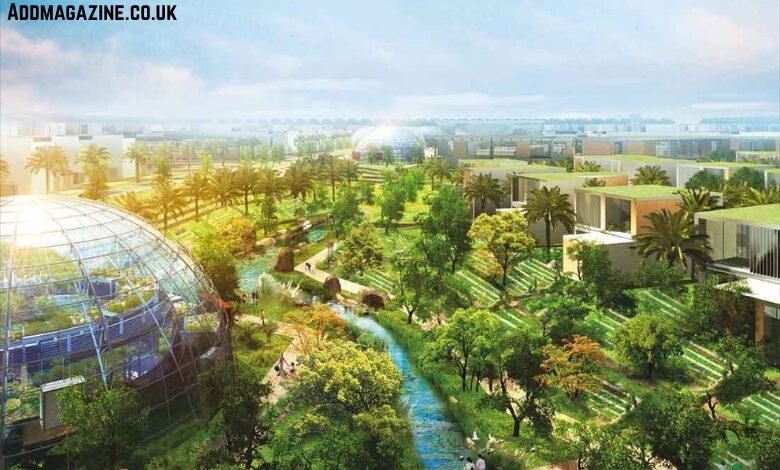Urban life is evolving under the combined pressures of rapid population growth, environmental change, and technological advancement. Planners, architects, and policymakers are searching for models that can create cities that are both functional and humane. One emerging concept is Axurbain, a framework that blends artificial intelligence, sustainability, and inclusivity into a single vision for future urban development.
The word itself can be broken down into two elements: axis, suggesting direction and structure, and urban, representing the city. Together, Axurbain describes a guiding framework for urban growth that prioritizes efficiency, resilience, and equity. Unlike purely theoretical models, Axurbain places emphasis on practical integration of technology with social and environmental needs.
This article explores Axurbain as a concept for city development, its guiding principles, applications, challenges, and potential impact on the future of urban living.
Core Principles of Axurbain
Axurbain is built on several foundational ideas. These principles form the basis for planning, design, and policy decisions within the framework:
- Sustainability – reducing environmental impact through renewable energy, green construction, and circular resource use.
- Technology Integration – using AI, IoT, and data-driven systems to improve city management.
- Inclusivity – ensuring all residents have equal access to services, opportunities, and urban benefits.
- Participatory Design – involving communities in decision-making and urban planning.
- Resilience – preparing for climate change, natural disasters, and social disruptions through adaptable infrastructure.
These principles are not unique in isolation. What sets Axurbain apart is the attempt to merge them into a coherent model, treating technology not as an end but as a tool to build livable, fair, and sustainable urban environments.
Technology in Axurbain
Technology plays a central role in the Axurbain framework. Unlike the “smart city” trend, which often prioritizes data collection and automation for efficiency, Axurbain emphasizes technology with purpose—tools that serve people, not the other way around.
Artificial Intelligence in Planning
AI can model traffic flows, energy consumption, or housing demands, helping policymakers make decisions that reduce congestion and improve access. Predictive algorithms can also identify vulnerabilities in water supply, transportation, or healthcare before they escalate.
Internet of Things (IoT)
Sensors embedded in streets, buildings, and utilities can provide real-time data on air quality, waste levels, or electricity usage. In an Axurbain city, this information feeds into systems that optimize resource allocation and reduce waste.
Mobility and Transport
Self-driving vehicles, integrated public transport apps, and bike-sharing systems can reduce reliance on private cars. AI can balance supply and demand, ensuring transport networks remain efficient even at peak times.
Digital Governance
Axurbain also promotes the use of digital platforms for governance. Mobile applications can enable residents to report problems, participate in surveys, or track city budgets. This creates transparency and strengthens trust between citizens and authorities.
Environmental Strategies in Axurbain
One of the defining challenges for modern cities is environmental sustainability. Axurbain envisions a future where ecological concerns are addressed through systemic planning.
Renewable Energy
Cities under the Axurbain model prioritize solar, wind, and other renewable sources. Smart grids adjust supply based on demand, reducing dependency on fossil fuels.
Green Infrastructure
Rooftop gardens, vertical forests, and urban wetlands are integrated into the built environment. These not only reduce carbon emissions but also cool cities, filter air, and provide recreational spaces.
Climate Resilience
Flood barriers, permeable pavements, and urban water retention systems protect against extreme weather. AI-driven climate models inform where and how infrastructure should be built.
Circular Economy
Waste is treated as a resource. Recycling systems, composting, and industrial symbiosis reduce landfill reliance and promote efficient use of materials.
By embedding these practices into city design, Axurbain creates environments where ecological sustainability is not an afterthought but a structural principle.
Social and Cultural Dimensions
Technology and environmental strategies alone cannot build livable cities. Axurbain also emphasizes social equity and cultural vitality.
Inclusivity
Public transport, healthcare, and education must be accessible to all residents regardless of income or background. Urban design includes ramps, tactile paving, and assistive technologies to support people with disabilities.
Affordable Housing
Housing policies encourage mixed-income communities rather than segregated zones. AI can analyze housing supply and predict shortages, helping governments intervene before crises develop.
Cultural Preservation
Axurbain cities are not designed as generic smart hubs. Local history, architecture, and cultural traditions are respected and incorporated into planning. Digital archives and AI-based cultural mapping ensure heritage is preserved while allowing for modernization.
Community Participation
Citizens play an active role in shaping their environment. Through digital forums, neighborhood assemblies, or participatory budgeting, residents influence the direction of urban projects.
Governance and Policy in Axurbain
For Axurbain to work, governance must adapt. Traditional urban management often struggles with fragmented responsibilities and slow bureaucratic processes. Axurbain proposes more integrated systems.
- Open Data Policies – making urban data available to the public for analysis and innovation.
- Cross-Sector Collaboration – connecting city governments, private companies, universities, and community organizations.
- Ethical Frameworks – regulating AI and data collection to protect privacy and prevent surveillance misuse.
- Citizen Feedback Systems – mechanisms for residents to regularly provide input and monitor government performance.
This model acknowledges that technology alone cannot solve urban problems; effective governance is essential to ensure fair and sustainable outcomes.
Case Studies and Inspirations
Although “Axurbain” is still an emerging concept, several real-world initiatives reflect its vision:
- Singapore Smart Nation Program – integrates sensors, AI, and urban planning to manage transport and energy use efficiently.
- Copenhagen’s Carbon-Neutral Goal (2025) – combines renewable energy, cycling infrastructure, and public participation to reduce emissions.
- Barcelona’s Digital Democracy Platforms – allows residents to propose and vote on local policies through online systems.
- Milan’s Vertical Forests – skyscrapers covered in greenery that improve air quality and provide habitats for wildlife.
These examples show that while no city fully embodies Axurbain, many are moving toward elements of its framework.
Challenges and Criticisms
Like any ambitious vision, Axurbain faces obstacles.
- Privacy Concerns – with extensive data collection, residents risk losing control over personal information.
- Costs – implementing smart infrastructure and renewable energy systems requires significant investment.
- Digital Divide – not all residents may have equal access to digital tools, creating inequality.
- Over-Reliance on Technology – cities may become vulnerable if AI systems fail or are misused.
- Cultural Homogenization – in focusing on efficiency, there is a risk of overlooking local identity.
Addressing these concerns requires careful planning, transparent governance, and ongoing community engagement.
The Future Outlook of Axurbain
Looking ahead, Axurbain offers a path for cities that balances efficiency, sustainability, and human needs. In the next two decades, we may see:
- Hybrid Governance Models – blending digital platforms with traditional decision-making.
- Fully Integrated Mobility Systems – seamless connections between autonomous vehicles, public transport, and micro-mobility options.
- Carbon-Neutral Districts – neighborhoods powered entirely by renewable energy and designed with circular economy principles.
- Adaptive Housing – modular, AI-monitored housing that adjusts energy use and space allocation in real time.
- Resilient Communities – urban areas designed to withstand floods, heatwaves, and other climate-related stresses.
If successful, Axurbain will not replace existing cities but guide their transformation. It offers a framework that is flexible enough to adapt to local conditions while addressing global challenges.
Conclusion
Axurbain is more than a buzzword; it is a vision for integrating technology, sustainability, and inclusivity into the fabric of urban life. While it draws from existing smart city initiatives, it goes further by insisting on equity, participation, and environmental responsibility as core requirements.
The success of Axurbain will depend not only on technology but also on governance, culture, and community. If implemented thoughtfully, it could help cities address some of the most pressing challenges of the 21st century: climate change, population growth, and social inequality.
Cities are complex organisms, and there is no single solution to their problems. But Axurbain provides a guiding axis—an orientation toward building urban environments that are not only smart but also fair, resilient, and sustainable.




